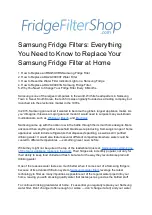
4
432-LIPPERT (432-547-7378)
Rev: 08.22.22
Floë
838 Integrated
Water Drainage System
Installation and Owner’s Manual
(For Aftermarket Applications)
CCD-0004086
Fig.5
1.
Locate water line entering the home.
NOTE:
If the main’s water line is under the floor, either drill
a hole in the floor directly under Floë using a
1/2
” drill bit
or locate a vent through which an air line can be fed. Use
snips or a hacksaw blade to cut an access hole in a vent.
2.
Turn off the water pump, if installed, and water supply
shutoff valve.
3.
Using pipe cutters or shears, cut through water line near
the water shutoff valve.
NOTE:
Use a cloth to mop up excess water from the cut
water line.
NOTE:
Make sure the ends of pipe are perfectly rounded.
If adjustment is needed, cover the ends with a cloth and
use pliers to round the ends.
4.
Slide both ends of the pipe firmly into the
1/2
” tee, utilizing
the tee’s push-fit connections
(Fig.5)
.
NOTE:
If larger or smaller pipes are used, adapters can be
purchased from hardware stores.
NOTE:
If flexible hose is used for the main’s water, utilize
the
1/2
” CTS barbed connectors and hose clamps to create
connections for the tee. See Figures 10 and 11.
5.
Measure the distance to connect the air line shutoff
valve on the Floë unit to the tee installed on the water line.
6.
Cut air line to length, leaving at least an extra half inch to
an inch of air line to slide into the connectors.
7.
Connect air line to both the shutoff valve and to the top
of the tee fitting
(Fig.5)
.
Connect to Power Supply
1.
Plug in Floë to an outlet.
2.
Use cable tie to hold together excess cord.
NOTE:
If the cord does not reach an outlet, an extension
cord may be used.
Test For Air Leaks
At this point Floë has been dry fit. It is worth testing that all
joints leading up to the main water line are fitted correctly
without air leaks. Locate the main water line tee and
remove the barbed connector from the short end of the tee
leading to the faucets, NOT the water tank long end. The
barbed connector is removed by pulling back on the collar
of the tee that holds the barbs in place.
Place a finger into the tee to seal this end and switch on
Floë. Floë should be tricked into stopping at 15 psi. If Floë
stops, then the joints leading to the water system are fine. If
Floë doesn’t stop, then remove, wet and reseat the air line into
the connectors leading back to Floë. It is essential there is a
good seal on the open end of the tee to allow this test to work.
Connect Tee Fitting, Hoses
NOTE:
Floë 115V AC Model 868 is normally used for
static-built properties. However, it can also be used on
moving vehicles and boats which, when stationary, are
connected to an AC supply The application will dictate
which tee to use, either Fig.5 or Fig.6. If using Floë 868 on
moving vehicles, consult the fitting instructions for Floë 636
which is normally used with 12V DC vehicles and boats.
(Fig.5)
The CTS
1/2
” one-way single valve tee with equal
length ends is for use with homes, model homes and any
other property with a main water supply. It is to be fit as
close to the main’s water top valve to aid draining the entire
system. See Operation section.
(Fig.6)
The CTS
1/2
” one-way double valve tee with one
short and one long end is for use with RVs and boats
where an onboard fresh water storage tank and an electric
pump is used. Fit tee with long end point toward the water
tank and the short end toward the filter and pump. See
fitting instructions for Floë Model 636.
Fig.6
short side to
filter/pump
long side
to tank


























